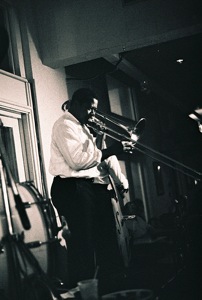
Since the days of Storyville, the legendary red light district that inspired the tune “Basin Street Blues,” it has been the speakeasies, the clubs, the stages of the city that have attracted entertainers and the legions who wish to be entertained. In the Big Easy, the nights are so anticipated that sometimes the days only get in the way.
The city has spawned many legends – from Jelly Roll Morton down to the Marsalis family. Located somewhere in between is perhaps the city’s foremost proponent of classic Dixieland, Pete Fountain. Almost every night you can see him down by the river at Pete Fountain’s Nightclub, playing with the same verve that he evinced when he began performing 50-something years ago.
The city has spawned many legends – from Jelly Roll Morton down to the Marsalis family. Located somewhere in between is perhaps the city’s foremost proponent of classic Dixieland, Pete Fountain. Almost every night you can see him down by the river at Pete Fountain’s Nightclub, playing with the same verve that he evinced when he began performing 50-something years ago.
For Fountain, to paraphrase the old saw, the road to Dixieland is never long. In other words, it’s been a great trip. “I was born and raised here,” he says of his native New Orleans, “I went to grammar school, high school, then I went to the ‘Conservatory of Bourbon Street.’ That was my schooling for years and I played all the way from strip clubs to the New Orleans Symphony. My ears were all here listening to all of the music as a kid.
“ I was lucky enough to come up and listen to a lot of great players out of New Orleans, like Louis Armstrong,” he remembers. “There was so much going on and there still is. Mostly all at that time it was Dixieland, a little jazz, a little progressive. The jazz was all around town.” Today it’s changed in form only, Fountain admits. “There’s lots of blues and a lot of rock. A lot of country now, you know, the Cajun, zydeco. You name it, we have it. We’re a collage, with so much talent down here. We go from Harry Connick, with the progressive piano and a progressive band down to me.” He chuckles at this last phrase, but he expresses an abiding principle of the music scene here. Though the beat may change over the years, the quality of the entertainment is constantly high.
And who better to make that call? After owning two clubs on Bourbon Street, and enjoying success these days down by the river, Fountain has seen it all. “We’ve been here for 25 years. I think the thing that helped this club off the ground was when I played Johnny Carson — 58 times. Almost 60. It really built this club up. I’m noticing now through the years, the regular customers are getting old, they’re not showing up. But we have some of the young kids coming in so it’s moving. It’s funny, the young kids, they think they’re discovering it,” he says, laughing. “I’ve been around for 100 years!”
Jazz clubs in the city run the gamut from Preservation Hall to Snug Harbor. While the former is a throwback to the past, a kind of time machine where the music and the humble surroundings create an unforgettable aura, the latter showcases contemporary sounds and stars of tomorrow. Maison Bourbon, just a drumstick’s throw from Preservation Hall in the Quarter, is right in the thick of things. You can hear some great sounds and watch the human parade pass by at the same time.
The large concentration of clubs on and adjacent to Bourbon Street makes it evident that New Orleans is indeed a musical gumbo. Rock, blues and Cajun music invite visitors to dance or just watch and soak in the energy.
All this proves that the music is one of New Orleans’ greatest natural resources. Great nightlife, however, does not live by music alone — nothing fuels mirth like a tasty libation. Pat O’Brien’s has proven this for more than half a century. The “Home of the Hurricane,” this legendary French Quarter hangout is a full-service saloon where anything goes — rollicking piano music, sing alongs, performing waiters — and, of course, the potent potable that put them on the map.
Shelly Waguespack represents the third generation of O’Briens to host fun-loving natives and visitors alike. She’s also a kind of historian of Pat O’Brien’s. “The bar opened in ’33 right after prohibition, legally opened,” she says, “and moved to its present location in the early ‘40s. My grandfather became the general manager shortly after that. It’s been in the family a long time.”
She also knows why Pat O’Brien’s has maintained its popularity all these years. “The piano bar has been around as long as the business has. We’ve had three generations of people coming in, coming back to the piano bar, the patio, getting their picture taken. The concept of the bar is dueling pianos,” Waguespack explains. “One singer will start off a song and the other will join in. They work together, and they’ll bounce off of each other and play with each other.”
The origin of the performing waiters? “We actually have a guy who works in the piano bar, his name is Eddie Gabriel. Eddie is 82, he’s been in Pat O’Brien’s for 61 years tapping the tray, making music at night. He started as a waiter, and he jumped on the stage and started playing the tray! It was an instant success. We recently celebrated his 60th anniversary last year.” Talk about longevity.
While the music keeps them coming back, the Hurricane gets them to sing along. It’s a New Orleans tradition that began in the 1940s merely as an expedient. “At that time there was a short supply of scotch and whiskey,” according to Waguespack. “Salesmen needed a way to force people to purchase rum, which was coming up the Mississippi from the Caribbean. So in order to purchase other products, they had to buy tons of rum. So they just came up with this drink through trial and error. And a salesman introduced them to the glass.” The rest is history.
(Published in New Orleans)




photo courtesy of StuSeeger